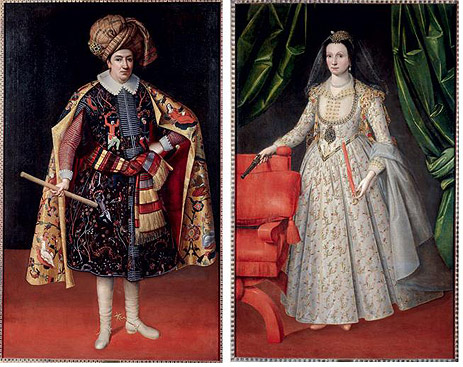Image Resource Bank
Image Gallery |  13 of 15
13 of 15 
Double Portrait of Sir Robert Shirley in Persian Dress and His Wife Teresia in European Dress
Conflicts between East and West have also made alliances between East and West. As early as 1536 CE the Ottomans joined forces with France against their common Habsburg enemies in Spain and Austria, and by the end of the century the shahs of Persia sought European alliances against the Ottomans. Among the envoys was Sir Robert Shirley, shown here beside his wife, Teresia. At the end of the sixteenth century, while western Europe was the theater of long struggle between Catholic and Protestant Christians and eastern Europe was the theater of long struggle between the Catholic Habsburgs the Muslim sultans of the Ottoman Empire, northwestern Iran and the Caucasus were theaters of another long conflict between the Ottoman rulers and the rising power of Safavid Persia. Like the conflicts in western Europe, the conflicts in the East were both territorial and religious, for the Ottoman sultans were Sunni Muslims, and the Safavid shahs were Shi’i. In 1598, Sir Anthony Shirley and his younger brother Robert came to the court of the Safavid shah Abbas I. As military advisors, they contributed to Persian victories over Ottoman forces. As diplomats, they accompanied Persian embassies to Europe when the shah sought alliances with Catholic rulers in Europe against the Ottomans to counteract long-standing Ottoman ties to France. When Robert Shirley led the second of these missions in 1609-1613, he was warmly received in the Holy Roman Empire, Italy, the Vatican, and Spain. In Europe, this embassy and other adventures of the Shirley brothers were material for pamphlets, drama, and art, including this double portrait. The painter played on notions of Eastern and Western identity, appearance, and even gender roles, showing Robert, the native Englishman, in the splendid regalia of a Persian courtier, with a diplomat’s baton, and Teresia, a Circassian born in the Middle East, in the splendid dress of a European lady, with a warrior’s pistol.
Name: Robert Shirley and His Wife Teresia
Material: Unknown
Size: Unknown
Date: ca. 1627 CE
Place of Origin: Unknown, Artist Unknown
Location: Collection of R.J. Berkeley
Source and Registration#: Wikipedia. Link to resource![]() (accessed June 24, 2010).
(accessed June 24, 2010).

 Matthew W. Stolper
Matthew W. Stolper
Professor of Assyriology and the John A. Wilson Professor of Oriental Studies




